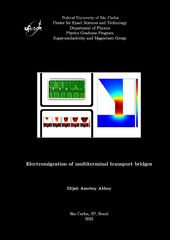Electromigration of multiterminal transport bridges
Resumo
With the continued miniaturization of integrated circuits (ICs), the case of metallic tracks subjected to stress caused by transport currents has become a matter of increasing concern, as it puts at risk the reliability of electronic devices. Because they are minuscule, on-chip interconnects in ICs are extremely prone to Electromigration (EM), which is a well-known cause of failure in semiconductor ICs, and through time, researchers have discovered ways to first control the wearout issue and then ultimately master it. However, the EM control reliability scenario is significantly changing in the current interconnect technologies, and a number of important issues need to be addressed.
This work is devoted to the investigation of current-induced modifications in micro-scale junctions and constrictions of superconducting and metallic materials.
In the first part of our experimental results, we investigate the targeted and localized material modifications produced by electropulsing on Al capped Nb microbridges with multiterminal configuration. The affected regions on the Nb/Al bilayer terminals are revealed by an in-lens secondary electrons detector in a scanning electron microscope as well as by Kelvin-probe Force Microscopy, both suggesting a decrease of the work
function in the modified areas. In contrast to that, the affected areas are neither apparent through an Everhart-Thornley secondary electrons detector nor through Atomic Force Microscopy, which indicates little morphological changes on the microstructure. In addition, we demonstrate that the extension of the electroannealed regions is strongly influenced by the terminal geometry. These results are captured by complementary finite element modelling which permits us to estimate a threshold temperature of (435 ± 35) K needed to induce material modifications. These findings provide further insights on the subtle modifications produced by gentle electroannealing of Nb/Al microstructures and represent a step forward towards mastering this emerging nanofabrication technique.
In the last experimental chapter of this thesis, we report on results concerning the structural modification of Al and Ni microconstrictions induced by elecropulsing by monitoring the resistance of the constrictions during EM in order to prevent permanent damages and preserve the junction for multiple trials. We applied current pulses to locally change the physical properties of the constrictions. Scanning Electron Microscopy inspection showed that the voids and hillocks found in EM of Al are noticeably missing in EM of Ni. The EM process in Ni occurs in a fairly well defined area, as one could predict in view of the occurrence of current crowding and local heating. EM in Al, on the other hand, appears to occur more randomly, possibly due to less transparent grain boundaries.
Collections
Os arquivos de licença a seguir estão associados a este item:

